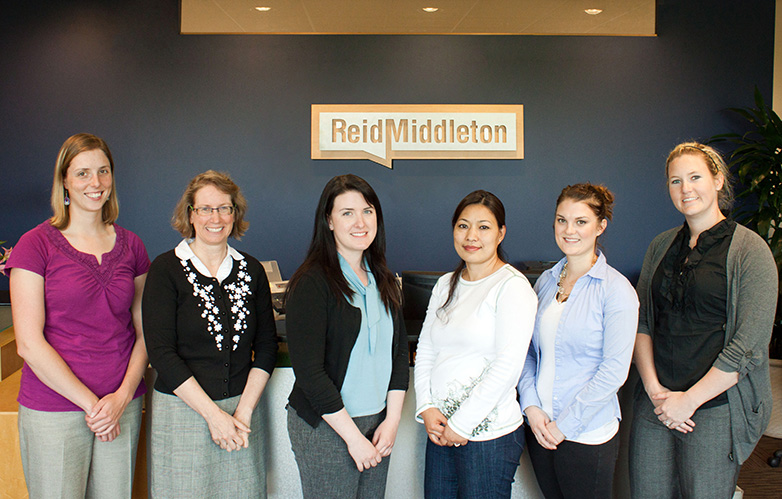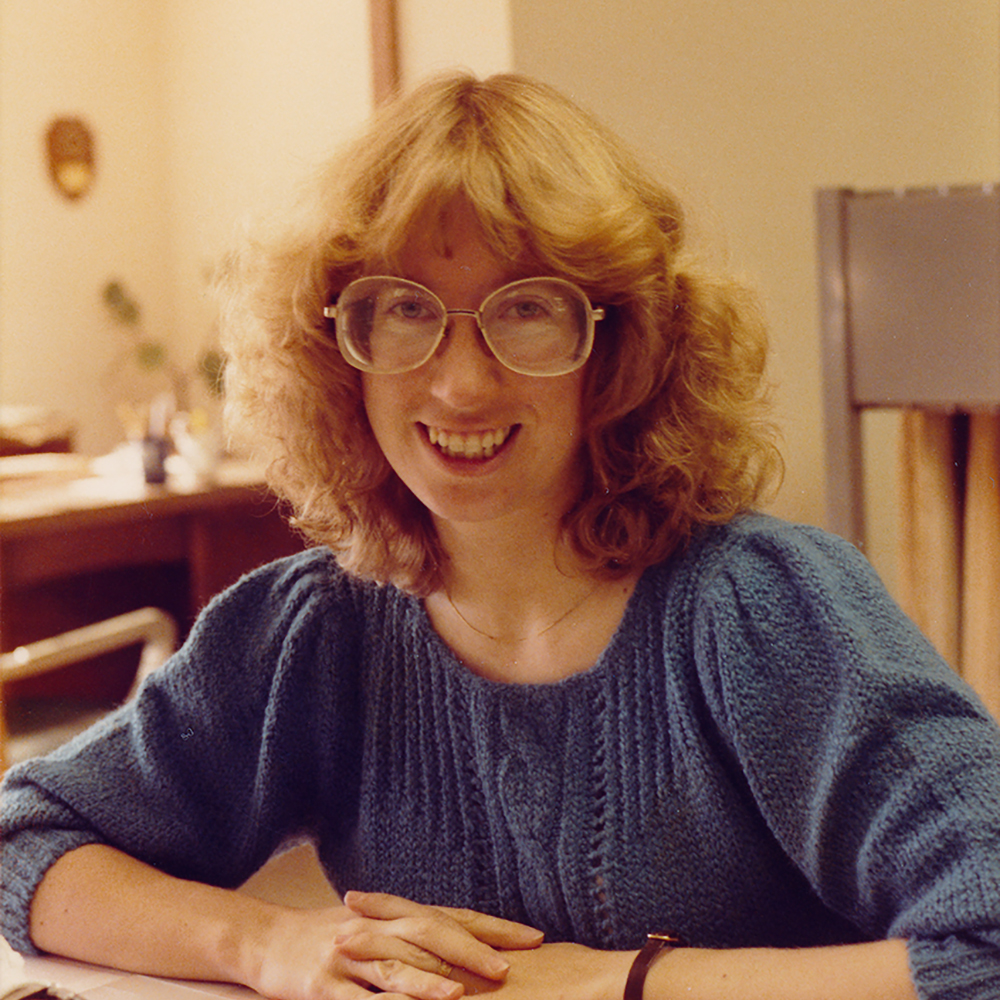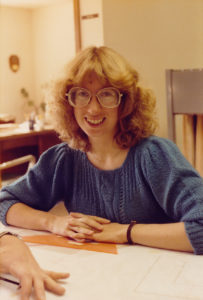The author in her early days at Reid Middleton.
Engineering is a perfect field for women. No heavy lifting (until the project is boxed up and filed), no manual labor (until you need to dig out a buried manhole cover). You get to work in a warm dry space, talk to interesting people, and do something new every day.
When I first started writing this blog, I asked myself why I was considering writing about the specifics of being a woman engineer and not just being an engineer. I have never felt that there should be a distinction between male and female engineers. I mean, we are all engineers doing the same type of work. But, in fact, for my age (not actually my age but the age of the era that I became an engineer), things were different, my perspective is unique, and offers a peek into recent history. Kind of a then vs. now discussion. What has changed or not.
Then
- I was one of two engineers in my all girl dorm at Washington State University (WSU) in 1978.
- I was in the third class to graduate women as Agricultural Engineers (Ag E), and the two previous classes were in the previous two years. The Ag E program had been around for decades.
- When I started my first job, the lunchroom was too small to accommodate the entire office so the women ate first and the guys followed. At first I was never quite sure when to go to lunch. If I went with the women, I stopped conversion as they wondered why an engineer (someone from upstairs) was sitting with them even though it was obvious that I was a girl. I usually wore skirts in the office and I wanted to talk about “girl” things like dating gossip and my upcoming wedding. On the flip side, if I ate with the guys, conversation stopped because “Why was a girl eating with them?” and “What was up with the hair bows?” (At the time, it was in vogue to have a giant hair bow that matched your skirt or blouse – just another ’80s fashion trend that has fortunately faded along with giant shoulder pads.) It didn’t take long to get both groups comfortable with an “outsider” in their group.
- When I started at Reid Middleton (a long time ago – mid ’80s), I was excited to work with not one but two other female engineers. My thoughts were “Where did they come from?” since I hadn’t had the opportunity to work with or ever be introduced to another female engineer by that time.
- We didn’t really know how to act or dress as we had no role models to emulate. I’m not sure just when I realized that I didn’t have to fit into the “girl engineer” box because there didn’t appear to be a box. I could quit looking and seeking and should just concentrate on being who I wanted to be and who I felt best represented women engineers in general.
- I was the first engineer at Reid Middleton to have a baby. The year was 1991, and the company was 38 years old. I asked about the maternity leave policy; I was told they didn’t have one and to go ahead and make a proposal. Since then, 12 babies have been born to female engineers at Reid Middleton.
- I was usually the only female at an interview or a client meeting.
Now

Now there are female city engineers, Public Works Directors, division heads and many project managers and project engineers that I cross paths with most every day. There are 12 women engineers (out of 48 total engineers) at Reid Middleton; one is Director of our Waterfront Projects group, and half of our transportation group is female. Of course, my role has changed from the young lady who needed guidance and direction to the mother figure of the younger engineers. They are all just starting their families at the time when my son is getting ready to graduate from college. (Talk about times changing – his engineering classes are full of girls!)
There was always a perception, and maybe there still is, that women engineers are different than men engineers. I never quite understood why there needed to be a distinction. We have families just like the guys. We may be the prime breadwinners of our family. We both come to work with the goal to do the best job for our clients and to design the most appropriate solution to the given problem. We want to fill our day with meaningful work and get paid for the effort. We want to gain more experience and more responsibility and move up within our organizations.
Truth is, we are all individuals who bring something unique to the design experience. Women working in (what used to be considered) a man’s field make the final product and the process getting there that much richer and more innovative.




Glad i found this post 🙂
We’re glad you’re here! Good luck with your pursuit of robotics!
Thankyou 🙂
Kelli, I echo your sentiments — having been one of few women in my engineering classes in the early 80’s and definitely in the minority at industry events when I first started attending. Today I serve as an officer on the Board for the Western District of ITE, and this year the Board has four women and three men, and this kind of “majority” first occurred five years ago when I was President. It is exciting to see more women in engineering and other math and science fields!
Hi Dalene,
Hope all is well in Santa Rosa! I love the new “majorities” that are popping up. Here’s to more of them!
Kelli
Thanks for sharing! I particularly like the part about the lunch room. I graduated engineering 5 years ago, but the engineering buildings, built in the 60s, were built without any women’s bathrooms. Many years later, they converted the bathrooms on certain floors to women’s, and it bugged me having to always take the stairs.
Tragic about the bathroom situation. But remember, taking the stairs is always good excercise! I am so glad that today’s architects and engineers are in tune with the diversity of employees, students and visitors in their designs.
Kelli
I am so happy to have found this blog! This was a fantastic article.
Glad to be found!
Welcome to the blog world Kelli! That was a great post. I have never felt like I didn’t fit in as a woman engineer. I am proud to say that I’m an engineer and presently its actually hard to say I’m a ‘home maker’…. temporary home maker, but its just as rewarding. 🙂
Holly, You will always be an engineer regardless of the length of the time you spend on other pursuits! Take Care, Kelli
Nicely written, Kelli.
Hey! Lovely to read your post. My job still feels like the ‘then’ list!! I’m one of 4 women in a building of about 240. I often gett he ‘lunch room’ thing on nights out where partners are invited – often feels like I don’t really ‘fit’ in either group-colleagues or partners!! Its all a bit of a learning curve for me even though I’ve been there nearly 2yrs. There’s no woman more experienced to ask that kind of question!
Fantastic article! I have been a chemical engineer for almost 13 years now — and I feel like being a women in this profession has changed even during this short time. If you work with a lot of mechanical and/or electrical engineers — they are still behind the times. These engineering fields are still dominated by men. I have always liked mechanical design — and I still sometimes have a difficult time with certain men accepting that I design and put together new ideas.
My name is Nehemiah Mabry and I’m a PhD student at NC State in Civil Engineering. I’ve started an initiative called STEMedia which aims to provide creative inspiration and motivation for the Science, Technology, Engineering and Mathematics community.
I’ve recently uploaded a short video on our YouTube page that was created to encourage women in engineering. I noticed this blog post where you celebrating the women engineers at your company and so I simply wanted to invite you to check it out at: http://youtu.be/MNGTCPHWMGQ
Thanks for taking the time and all the best to your business!
Thank you for your comment Nehemiah! We wish you the best of luck with your initiative.